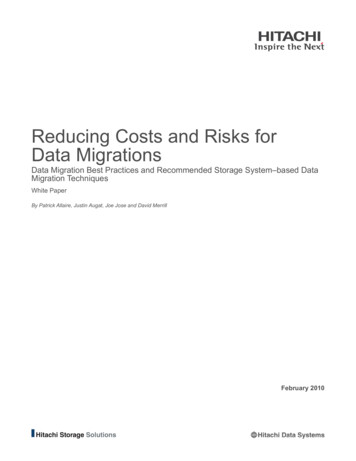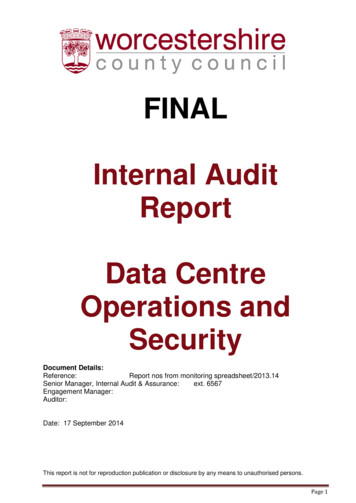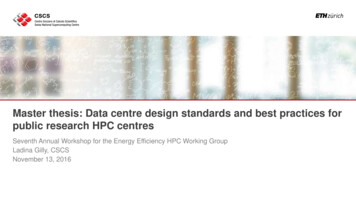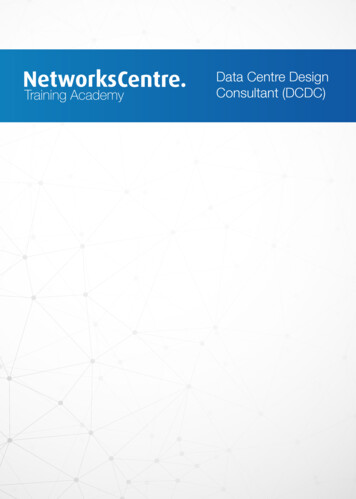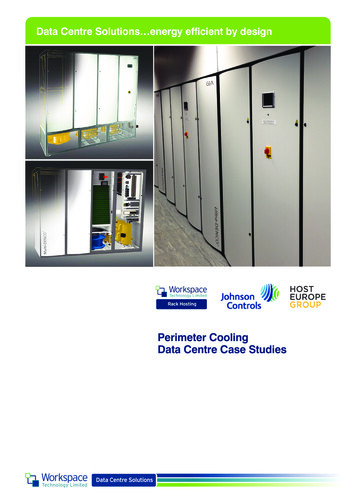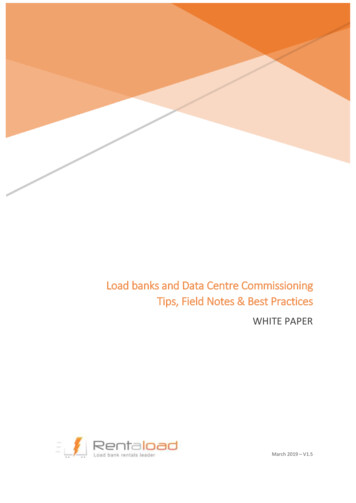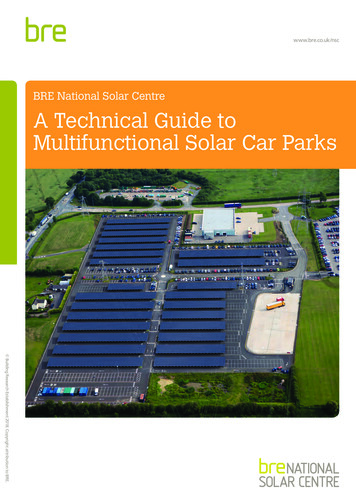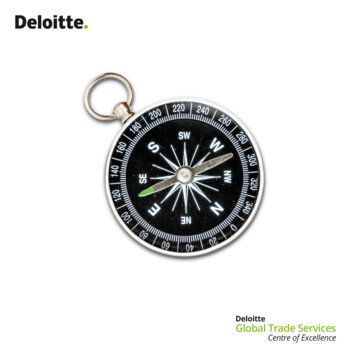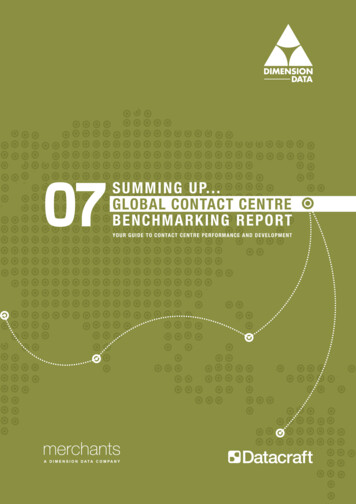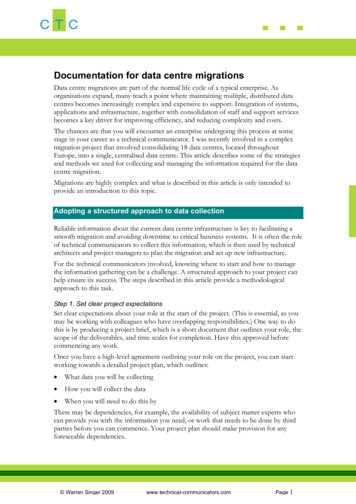
Transcription
Documentation for data centre migrationsData centre migrations are part of the normal life cycle of a typical enterprise. Asorganisations expand, many reach a point where maintaining multiple, distributed datacentres becomes increasingly complex and expensive to support. Integration of systems,applications and infrastructure, together with consolidation of staff and support servicesbecomes a key driver for improving efficiency, and reducing complexity and costs.The chances are that you will encounter an enterprise undergoing this process at somestage in your career as a technical communicator. I was recently involved in a complexmigration project that involved consolidating 18 data centres, located throughoutEurope, into a single, centralised data centre. This article describes some of the strategiesand methods we used for collecting and managing the information required for the datacentre migration.Migrations are highly complex and what is described in this article is only intended toprovide an introduction to this topic.Adopting a structured approach to data collectionReliable information about the current data centre infrastructure is key to facilitating asmooth migration and avoiding downtime to critical business systems. It is often the roleof technical communicators to collect this information, which is then used by technicalarchitects and project managers to plan the migration and set up new infrastructure.For the technical communicators involved, knowing where to start and how to managethe information gathering can be a challenge. A structured approach to your project canhelp ensure its success. The steps described in this article provide a methodologicalapproach to this task.Step 1. Set clear project expectationsSet clear expectations about your role at the start of the project. (This is essential, as youmay be working with colleagues who have overlapping responsibilities.) One way to dothis is by producing a project brief, which is a short document that outlines your role, thescope of the deliverables, and time scales for completion. Have this approved beforecommencing any work.Once you have a high-level agreement outlining your role on the project, you can startworking towards a detailed project plan, which outlines: What data you will be collecting How you will collect the data When you will need to do this byThere may be dependencies, for example, the availability of subject matter experts whocan provide you with the information you need, or work that needs to be done by thirdparties before you can commence. Your project plan should make provision for anyforeseeable dependencies. Warren Singer 2009www.technical-communicators.comPage 1
Your plans should also provide sufficient flexibility to accommodate changes torequirements, processes and tools during the course of the project.Figure 1. Simplified example of a project planStep 2. Clarify what data you need to collectEnsure that key business stakeholders are engaged and given an opportunity to providetheir feedback as to what information they want collected. Key stakeholders shouldrepresent IT infrastructure, IT security, business continuity planning, applicationarchitecture, service management and any other business areas that are either impactedby the migration or involved in migration planning.Note: Failure to engage at the planning stage with relevant business stakeholders could result in yourteam having to repeat the data gathering exercise at a later stage, as you did not capture all theinformation required. This could add significantly to project costs and cause delays to migration.It is sometimes tricky to determine the level of detail you need when collectinginformation. Asking for too much detail could significantly slow down migrationplanning. Ask for too little detail and you may not have enough information to plan themigration.The following examples illustrate the type of information you may need to collect. Theprecise details will depend on the organisation and the nature of the project.Server dataYou will need to collect data on the physical infrastructure that is target for migration.Table 1 outlines typical server information:Table 1. Server details Memory, disk and processor specifications Operating systems Services Serial numbers (e.g., for hardware and operating system) Host names and IP addresses Maintenance agreements Age of the machine and any service level agreements (SLAs) Physical dimensions — size, weight Warren Singer 2009www.technical-communicators.comPage 2
Table 1. Server details Rack location/blades Peripherals: monitors, keyboards or other equipment Heating and ventilation requirements Security requirements Power supply requirements Number of available ports/slotsPhysical dimensions, and heating and cooling considerations will determine the availablespacing and new room arrangements. Security requirements will determine who hasaccess to the new equipment and the type of access to the room. Old servers that havebeen running for a number of years may not restart easily if shut down. In this case,migration planners might consider purchasing new kit. If applications on current serverswill be installed on new servers or virtualised, the planner needs to ensure that the newservers have sufficient ports. New maintenance agreements may need to be arranged,especially if the server will be running from a different region.Migration planning, based on the information you collect, will determine whether aserver can be lifted and shifted to a new location, or whether a new version needs to bebuilt on new hardware.Application dataTo avoid confusion, it helps to have a clear business definition of what constitutes an‘application’. For example, how does your business see this as differing from a service orprocess?Collecting application information is a complex and time-consuming task. There may benumerous applications installed on each physical server. Each application may in turnconnect to several other applications. Some of these applications may be hosted on site,others may be hosted on sites belonging to third parties.Application discovery can be complicated if an enterprise is not aware of all its currentapplications. A large enterprise can run hundreds of applications in each data centre. Inthis case, one of your first tasks may be to create an up-to-date list of applications.Table 2 provides examples of some of the application details you may need.Table 2. Application details Application purpose/function Service Level Agreements (SLAs) Business criticality measures Business services/products and processes supported Warren Singer 2009www.technical-communicators.comPage 3
Table 2. Application details Maintenance windows, change freezes and backup times Users and customers supported Application sponsors, subject matter experts, commercial owners and deliveryowners Application architecture and network topology Upstream and downstream applications connected to this application Ports and firewalls Application interfaces (e.g., fax, mail relay, printing) Hosting arrangements: such as production, disaster recovery, test and developmentenvironments, their IP addresses and whether they are physical or virtual Location (data centre/country where installed) Licence details – type, serial numbers Any planned changes/upgrades Operating systems, databases and versions Messaging (e.g., MQ, FTP) Data storage and archiving requirements Supported batch processes and work flowsIdentify a contact person, owner and sponsor for each application. Make sure you have aclear definition of owner, contact and sponsor as these are different roles. The contactprovides information. The owner must have decision-making ability, be accountable forthe decisions made and specify what testing will be needed. The sponsor represents thebusiness or client. Often they do not know the technical details of the application. Allroles are important. It takes time to clarify roles and is not always straightforward.Prioritise your applications — identify which applications should be targeted first fordata collection. You could base this priority on regional or project considerations — theplan might be to migrate each region or data centre in stages. Additionally, you wouldwant to prioritise your information collection to focus first on applications that are key tothe business. This may involve discussions with key business stakeholders, who have agood understanding of the core applications in their business area.You may also want to prioritise the information you collect, to distinguish essentialinformation from nice to have. The key application information you need includes theapplication owner, the criticality of the application, maintenance windows, SLAs, andhow the application links to other applications and to external clients. This information isused to determine the impact and timing of the application migration. Warren Singer 2009www.technical-communicators.comPage 4
For example, if application A connects to business-critical applications B, C and D, thenthe migration planners may decide to move all these applications at the same time.Available maintenance windows determine when they can be moved. SLAs determinehow much system downtime can be tolerated and who can approve extensions. You willneed a business owner to confirm any migration decisions made.Adopting a staged approachWhen a large amount of information needs to be collected, it makes sense to break downthe information collection into stages. For example:Stage 1: Collect high-level information on current infrastructure and applications. Forexample, what’s out there? What does it run on? How important is it to the business?Does it need to be migrated?Stage 2: Collect detailed information on relevant applications and servers that need to bemigrated.This flexible approach was one we adopted on our project. It enabled a quick initialinformation gathering exercise to be completed, which then lead to a detailed discovery.This also ensured that subject matter experts were not overwhelmed with requests forinformation at a single point in time, minimising the impact on regular business activities.Step 3. Define the methods and tools to be used for data collectionThe methods and tools used for collecting information depend on the nature of both thedata and the organisation. You can use a combination of the examples shown in Table 3.Step 4. Determine how information will be stored, maintained and presentedIt is essential that the information you collect is stored in a format that is easilyupdateable and retrievable by relevant areas of the business. If this information can beentered into a database, this makes it easier to generate reports and retrieve the data, aswell as providing version control and tracking.Companies that specialise in migration services provide database tools specificallydesigned for this purpose.Step 5. Identify areas in the business that need to be contactedThe information you need to collect may span different business areas andresponsibilities.You will need to discover how the infrastructure is managed, as IT systems will besupported and owned by different departments. For example, mainframe, Windows,Unix systems and telecommunications equipment are usually managed by separate teams.This becomes even more complicated when businesses are spread across countries andregions, as some regions may have wider responsibility for elements of the infrastructure.Clarify what business areas are involved and obtain nominated people who will be yourcontact and sponsor in each area. Warren Singer 2009www.technical-communicators.comPage 5
Step 6. Define a clear communication strategyClear stakeholder management is vital in large migration projects. You may need tocommunicate with key decision-makers and subject matter experts located acrossdifferent business areas and regions. Providing a consistent message and approach willmaximise co-operation with the data collection effort.A clear communication plan should include: The communication process (who is involved, and how and when you will becommunicating) Response times for returning information requested Escalation procedures E-mail and communication templatesThe key to an effective communication plan is to ensure that it fits into the organisation’sexisting structure and work practices, and can be easily implemented.Table 3. Data collection methods and toolsElectronic datacollectionAutomated scripts or queries that can be run on machines in the network to collect basicinformation on operating systems, IP addresses, applications, services, protocols, datavolumes and data flows. Software may already be installed that monitors and providesstatistics on the network.QuestionnairesProvide a standard format for collecting information that cannot be obtained electronically.They may be presented as simple Excel spreadsheets, with fields that contacts need tocomplete, or HTML forms that can be submitted online.DiagramsDescribe the connection between components and external clients, upstream anddownstream data flows, where servers are located and how they are connected to thenetwork.Interviews andworkshopsEnable more detailed discussions and identification of obstacles to migration. Once you’vemanaged to collect basic information on applications, services and infrastructure, it isessential to get owners together to discuss the components in their area and how these canbe best migrated.PhysicalinspectionA physical audit of the boxes and cabling to identify serial numbers, available ports andwires connected to machines.TechnicaldocumentationSystem documentation, user guides, legacy plans and process documentation may beavailable for key systems. If not, you may need to create new documentation to fill in gaps.DatabasemanagementsystemsContain data on existing infrastructure and applications. Databases can be queried and usedto generate reports. Some suppliers of
Figure 1. Simplified example of a project plan Step 2. Clarify what data you need to collect Ensure that key business stakeholders are engaged and given an opportunity to provide their feedback as to what information they want collected. Key stakeholders should represent IT infrastructure, IT security, business continuity planning, applicationFile Size: 238KBPage Count: 10
